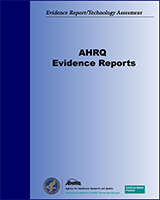NCBI Bookshelf. A service of the National Library of Medicine, National Institutes of Health.
Hartmann KE, McPheeters ML, Biller DH, et al. Treatment of Overactive Bladder in Women. Rockville (MD): Agency for Healthcare Research and Quality (US); 2009 Aug. (Evidence Reports/Technology Assessments, No. 187.)
This publication is provided for historical reference only and the information may be out of date.
- ±
plus or minus
- ≤
less than or equal to
- ≥
greater than or equal to
- AE
adverse events
- AHCPR
Agency for Health Care Policy and Research
- AHRQ
Agency for Healthcare Research and Quality
- AUC
area under the curve
- AUM
ambulatory urodynamic monitoring
- avg.
average
- BAPFMT
biofeedback-assisted pelvic floor muscle training
- BFQ
Bladder Function Questionnaire
- b.i.d.
twice a day
- BL
baseline
- BM
bowel movements
- BMI
body mass index
- BOO
bladder outlet obstruction
- BPH
benign prostatic hyperplasia
- bpm
beats per minute
- BRD
bladder retraining drill
- BT
bladder training
- CEE
Conjugated equine estrogens
- CHF
Congestive heart failure
- CI
confidence interval(s)
- cm
centimeter
- cmH2O
centimeters of water
- CR
controlled release
- CS
cognitive strategies
- CT
combination therapy
- CUBS
Compromised urinary bladder syndrome
- d
day
- d/t
drug treatment
- DI
Detrusor instability
- dL
deciliter
- DM
Diabetes mellitus
- DO
detrusor overactivity
- Dx
diagnosis
- EKG
electrocardiogram
- ER
extended release
- ES
electrical stimulation (electrostimulation)
- etc.
et cetera
- EtOH
Ethanol (alcohol)
- F
F-distribution
- G
group
- GI
gastrointestinal
- GII
global impression of improvement
- GSI
genuine stress incontinence
- GU
genitourinary
- HAD
Hospital Anxiety and Depression Scale
- H2O
water
- hr(s)
hour(s)
- HRQoL
Health related quality of life
- HRT
hormone replacement therapy
- Hx
history
- Hz
hertz
- IBD
irritable bowel disease
- IC
interstitial cystitis
- ICIQ
International Consultation on Incontinence Modular Questionnaire
- ICIQ-SF
International Consultation on Incontinence Questionnaire-Short Form
- IIQ
Incontinence Impact Questionnaire
- IIQ-R
Incontinence Impact Questionnaire-Revised
- IMPACT
Improvement in Patients: Assessing symptomatic control with tolterodine
- IQR
interquartile range
- IR
immediate release
- ITT
intention to treat
- IUSS
Indevus Urgency Severity Scale
- KQ
key question
- kg/m2
kilograms per meter squared
- KHQ
King’s Health Questionnaire
- L
liter
- LCB
low-compliance bladder
- LOCF
last observation carried forward
- LOS
length of stay
- LS
least square
- Ltd
limited
- LTFU
Loss to followup
- LUT
Lower urinary tract
- LUTS
Lower urinary tract syndrome
- mg
milligram
- min
minute(s)
- mL
milliliter
- mL/s
milliliters per second
- mm
millimeter
- MMSE
Mini Mental Status Exam
- mo(s)
month(s)
- MUI
Mixed urinary incontinence
- MVV
Mean volume voided
- n, N
number
- ng
nanogram
- NIH
National Institutes of Health
- NR
not reported
- NS
Not significant
- OAB
Overactive bladder
- OAB-q
OAB questionnaire
- OAB-SCS
OAB-Symptom Composite Score
- OCAS
oral controlled absorption system
- P, p
p value
- PFME
pelvic floor muscle exercises
- PFMT
pelvic floor muscle training
- PGA
patient-reported goal achievement
- PISQ
Pelvic Organ Prolapse/Urinary Incontinence Sexual Questionnaire
- PME
pelvic muscle exercises
- PNN50
measure of heart rate variability
- P.O.
per oral (by mouth)
- PPBC
Patient perception of bladder condition
- PPBCS
Patient perception of bladder condition scale
- PPIUS
Patient Perception of Intensity of Urgency Scale
- PPPY
per person per year
- PRO
Patient reported outcome(s)
- Pt
patient
- PVR
post-void residual
- qAM
every morning
- qd
every day
- qid
four times per day
- QoL
quality of life
- QTcB
QT interval correct for heart rate using Bazett’s formula
- RCT
randomized controlled trial
- RTX
resiniferatoxin
- s
second
- SCL-90-R
Symptom Checklist-90-Revised
- SD
standard deviation
- SE
standard error
- SF
Sexual function
- sec
second
- SNM
sacroneuromodulation
- SQoL-F
Sexual Quality of Life Questionnaire-Female
- subj.
subjects
- SUI
Stress urinary incontinence
- Sx
symptoms
- t.i.d.
three times a day
- TDS
transdermal delivery system
- UDI
Urogenital Distress Inventory
- UDS
urodynamics
- UFICQ
Urinary Frequency and Incontinence Questionnaire
- UI
urinary incontinence
- US
United States
- UTI
urinary tract infection
- UUDI
Urge Urogenital Distress Inventory
- UUI
Urge urinary incontinence
- VAS
visual analog scale
- vs., v
versus
- w/
with
- wk(s)
week(s)
- x
times
- yr(s)
year(s)
- List of Acronyms/Abbreviations - Treatment of Overactive Bladder in WomenList of Acronyms/Abbreviations - Treatment of Overactive Bladder in Women
- Conclusions - Enabling Medication Management Through Health Information Technolo...Conclusions - Enabling Medication Management Through Health Information Technology
- Appendix B: Data Abstraction Forms - Diagnosis and Treatment of Worker-Related M...Appendix B: Data Abstraction Forms - Diagnosis and Treatment of Worker-Related Musculoskeletal Disorders of the Upper Extremity
- Preface - Bioterrorism Preparedness and ResponsePreface - Bioterrorism Preparedness and Response
- Introduction - Treatment of Overactive Bladder in WomenIntroduction - Treatment of Overactive Bladder in Women
Your browsing activity is empty.
Activity recording is turned off.
See more...
